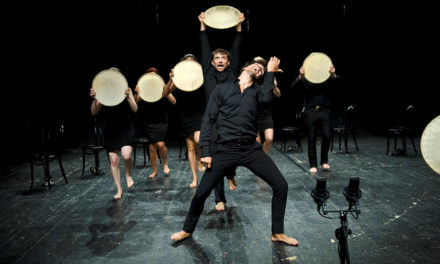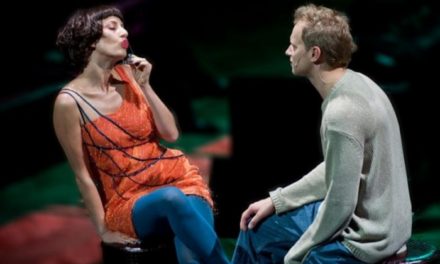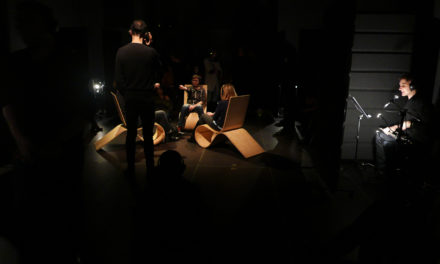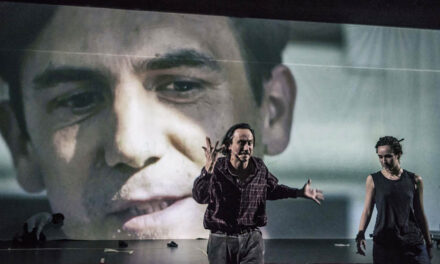For some of us, the critical process, our practice – that is, what we do – is a continuous and contentious intersection of reading, thinking, challenging, transgressing, swerving and writing. It is often an exploration of interstices, of betweenness, of neither as a space, of looking elsewhere, and so the conducive literary figures are those whose work accommodates such a stuttering process of contraction and expansion, what James Joyce has called peristaltic, as style and heuristic, one that is as much undoing as doing. That peristaltic critical process, a stuttering, interrupted heuristic finds one of its havens in theatrical space where theory and performative praxis enjoy a symbiosis, a fulfilling mutuality, where theory is embodied and problematized and the space between the articulable and inarticulable explored in ghostly images, theatre’s thereness challenged. Meaning itself can be stated, performed, vanish, reappear – or not. For the past dozen or so years, the Between.Pomiędzy Festival of literature, theory and performance, under the stuartship of Prof. Tomasz Wiśniewski and his team, has afforded the opportunity for such aesthetics of hesitations, has been a space where such interstices could be probed, explored, breached, at times without aesthetic product, as pure theatrical research, but at times producing tangible entities.

International theatre collaborators (L-R), legendary Polish actor Ryszard Ronczewski, director Gontarski, British actor John McKenna
Most conducive experiment, in literary research and performance, draws on a cross section of participants that the Between. Pomiędzy festival continues to attract, and that cross section includes as much local talent as major international figures and that mix has generated something of a cross-pollination of personalities, ideas, and skills, including multilingual performances and hybrid productions of live and filmed spectacles. Much of my theatrical experiment has taken its lead from Beckett who in a letter to Hans Naumann of 17 February 1954, speaks to the issue of creative influences in response to Naumann’s inquiry, “Has the work of Kafka ever played a part in your spiritual life?” In his response Beckett noted, “I am not trying to resist influence. I merely note that I have always been a poor reader, incurably inattentive, on the lookout for an elsewhere [‘à l’affût d’un alleurs’]. And I think that I can say, in no spirit of paradox, that the reading experiences which have affected me most are those that were best at sending me to that elsewhere.” Such praise of inattention is what Catherine Belsey might call my “Critical Practice,” not so much influence, that is, which suggests an adopted lineage, but a looking away, an aesthetics “on the look-out for an elsewhere,” which avoids the duplication that influence suggests. It is driven by something of a creative hesitation, uncertainty or creative distraction that cuts into or across current spaces, on page or stage, and severs them, cuts received lines of thought, opens them to previously overlooked, underplayed, and misinterpreted entities that reside in the elsewhere. What follows is a series of images from what had become, surprisingly, inadvertently, an engagement with a theatre (and criticism) of elsewhere in a groping for what has been missing, hidden, overlooked, lost.

Figure 3: Workshop rehearsals for bilingual production of Samuel Beckett’s Ohio Impromptu, (L-R) McKenna, Ronczewski. Special acknowledgements to Antoni Libera for Polish translation of Ohio Impromptu.
Such a process of research discovery can also be facilitated by accident or fortuitous conjunction. Taking a break from rehearsals on . . .but the clouds. . ., I went down to the theatre bar for some adult refreshment. I sat down next to someone holding a sack of curious instruments, which turned out to be Tibetan flutes. He was a Polish musician, Łukasz Sabat. After a short conversation, I invited him up to the theatre to join rehearsals, and he did and began improvising melodies on a variety of instruments, all of which created an eerie but soothing, om-like trance sound that punctuated our sense of elsewhere. He played through the remainder of the rehearsals, but we decided not to use the music in the final film in deference to Beckett’s oft expressed prohibition against musical enhancements to performance. I now deem that decision a mistake, the result of undue deference, but I would like a second chance to build a new production of another Beckett teleplay with less respect, less deference, Ghost Trio, say, with Sabat’s musical improvisations.

Figure 5 Staging and filming Samuel Beckett’s teleplay. . .but the clouds. . . with British actress Lil Warren and Polish cinematographers Szymon Uliasz and Magdalena Giubała. Between.Pomiędzy 2018. Special acknowledgements to Antoni Libera for providing a Polish translation of . . .but the clouds. . . used to subtitle the film. Photo provided by the author.

Figure 5 Staging and filming Samuel Beckett’s teleplay . . .but the clouds. . . with British actress Lil Warren and Polish cinematographers Szymon Uliasz and Magdalena Giubała. Between.Pomiędzy 2018. Special acknowledgements to Antoni Libera for providing a Polish translation of . . .but the clouds. . . used to subtitle the film. Photo provided by the author.
But the international element of Between.Pomiędzy is a two way street, and the cross pollination can drift as far as the southern hemisphere as with a series of workshops with Brazilian actors in the theatre group Maskara in Goiania, Brazil.
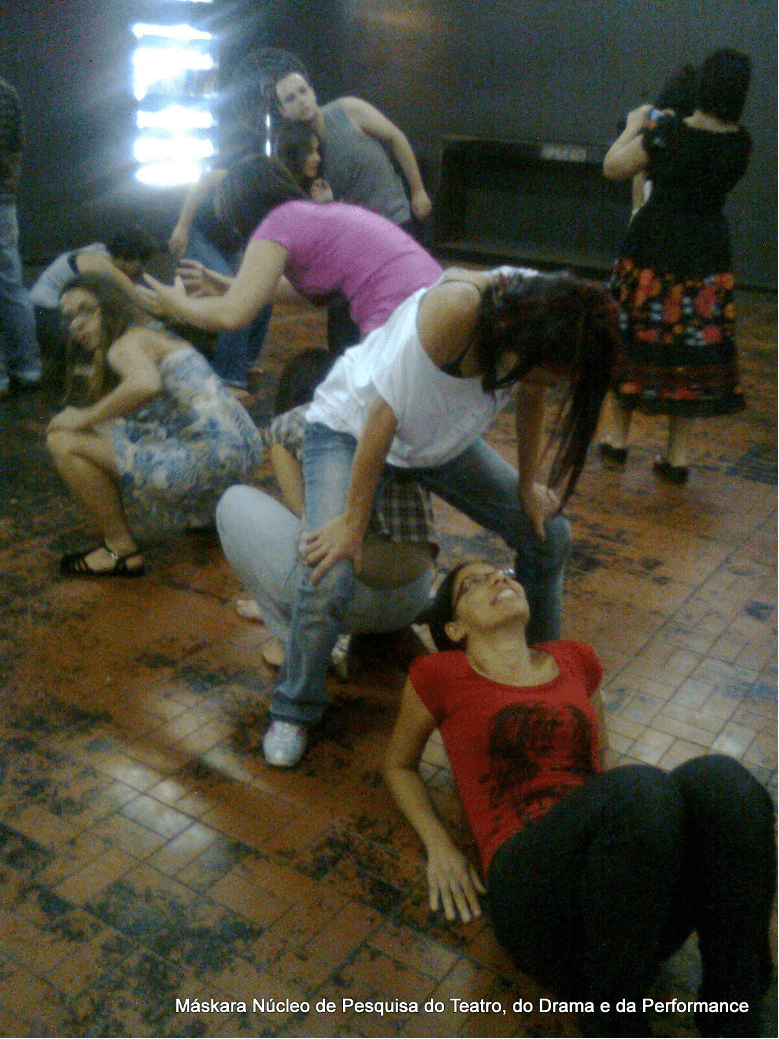
Photo Credit: Stanley Gontarski
Such workshops, exercises in acting technique designed to stretch creative possibilities, led to the creation of a Samuel Beckett Evening: Breath—Texts—Breath. The performance was staged in London, then presented as part of the Florida State University Theatre Academy in London (an actor training center) and subsequently toured Poland as an international entry in the Between.Pomiędzy Festival.

Breath—Texts—Breath played at the Calder Bookshop and Theatre, London, on 2, 8-9 December 2010, reprised on15-16 April 2011. A Polish tour began at Teatru Wybrzeże, Scena Kameralna, Sopot, Poland on 20 May 2011; and played at Teatr w Oknie, Gdańsk, Poland, 21-22 May 2011. The Polish performances included and were enhanced by Antoni Libera reading his Polish translation of the Text of the title.
We attained some redress from the timidity of the . . . but the clouds . . . workshops the following year with a production that cracked theatre walls, an experiment designed as a film from the first, a composite of love’s failures called Beckett on the Baltic: Love’s Labor’s Lost, which took on a specific and recognizable space, complete with landmarks, and dislodged them, rendering the landscape (or seascape) irrelevant to the nowhere or elsewhere of the protagonist’s hauntings, his living among ghosts in an elsewhere (from the Baltic, at very least), external space superseded by the protagonist’s hauntology. Such hauntings were now punctuated by music, the Salesian String Quartet performing the Animato con passione. Largo. Lento dolcissimo by Andrzej Korzanowski and “Song to the Virgin Mary” for String Sextet by Andrzej Panufnik (see excerpts from the 2003 album performed on Polskie Radio Katowice: https://www.youtube.com/watch?v=sFVlx0uulVg and https://youtu.be/sFVlx0uulVg). The ghosts that were animated and so visible in the Ohio Impromptu workshop (as above) were now returned to the realm of the invisible within the prison house of memory.
As important as the addition of music to the international mix of Beckett on the Baltic: Love’s Labor’s Lost was a determination to swerve, to break the mold, to move elsewhere, to recalibrate the idea of influence, which Beckett understood fully in 1954 (soon after he had gone public as a professional dramatist) with his response to the question of Kafka’s influenced on his work. In Beckett’s thinking influence was simply a synonym for belatedness, repetition, a concern that he wrestled with for a time over his relationship with James Joyce – and now, apparently, with Kafka as well. To this day, however, critics insist on repeating the bromide that Beckett was Joyce’s heir, some kind of intellectual offspring direct in lineage. If we consider Beckett on the Baltic as the endpoint of a series of Between.Pomiędzy Festival Beckett workshops (more pause that endpoint, actually), it may be a most un-Beckettian point. And yet, it is the nature of experiment, which such international workshops foster, to stretch a text, to generate alternatives, to probe possibilities, and, most important, to swerve, to avoid repetition, to avoid duplication. Such is the research function of theatre workshops, after all, and in this case to offer another possible, alternate ghost story amid a site-specific elsewhere dominated by visual echoes and image clusters.
This text was written with the support of Between.Pomiędzy Research Group.
References
Between.Pomiędzy festival link: https://www.between.org.pl/en/festivals/kosmopolis/between-research/chapter-3 [Includes links to films.]
Breath—Text—Breath https://www.youtube.com/watch?v=FxnTzeCtdO0
Gontarski, S. E. “Ghosts of Love: ‘Ohio Impromptu,’ and ‘… but the Clouds ….’” Samuel Beckett Today / Aujourd’hui, vol. 30, no. 2, 2018, pp. 167–78. JSTOR, https://www.jstor.org/stable/26552595. Accessed 17 Nov. 2023.
Gontarski, S. E. “‘An American bitch’: Beckett’s ‘Love’s Labor’s Lost.’” Tekstualia, 2020; 2 (6): 73-86. (Special issue: Islands and Laboratories). Eds. Tomasz Wiśniewski, Klaudia Łączyńska, and Izabella Curyłło-Klag. https://tekstualiascience.com/resources/html/article/details?id=209767&preview=true
Malcolm, David. Review of “Breath—Text—Breath”: “Street Beckett in London,” The Beckett Circle: Newsletter of the Samuel Beckett Society. Vol. 34, No. 1 (2011): 1-2.
Sabat, Łukasz. https://soundcloud.com/look-sabat
“Samuel Beckett Presented on Screen and Stage”: https://english.fsu.edu/article/samuel-beckett-presented-screen-and-stage
This post was written by the author in their personal capacity.The opinions expressed in this article are the author’s own and do not reflect the view of The Theatre Times, their staff or collaborators.
This post was written by S.E. Gontarski.
The views expressed here belong to the author and do not necessarily reflect our views and opinions.


